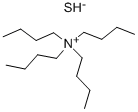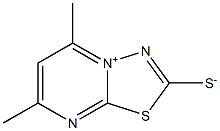ammonium hydrogensulphide
- CAS NO.:12124-99-1
- Empirical Formula: H5NS
- Molecular Weight: 51.11
- MDL number: MFCD05863649
- EINECS: 235-184-3
- SAFETY DATA SHEET (SDS)
- Update Date: 2024-12-18 14:07:02

What is ammonium hydrogensulphide?
Chemical properties
Ammonium sulfide is a yellow crystalline (sugar or sand-like) material, commonly found in liquid solution, which is flammable. Solution has an odor of rotten eggs.
Physical properties
White tetragonal or orthorhombic crystal; density 1.17g/cm3; refractive index 1.74; unstable, sublimes readily at ordinary temperatures; vapor pressure 748 torr at 32°C; highly soluble in water, alcohol, liquid ammonia and liquid hydrogen sulfide; insoluble in benzene, hexane and ether.
The Uses of ammonium hydrogensulphide
In lubricants.
Definition
The true sulfide is sta- ble only in the absence of moisture and below 0C. The ammonium sulfide of commerce is largely ammonium bisulfide or hydrosulfide, NH 4 HS.
Preparation
NH4HS is prepared by the reaction of an equimolar amount of ammonia and hydrogen sulfide:
2NH2HS + 2S → (NH4)2S3 + H2S.
General Description
Clear, yellowish liquid. Kept basic with NaOH, as acid will release hydrogen sulfide gas. Technical grade is 40-44%. Used in photography, textiles, synthetic flavors, coloring brasses, bronzes, and iron control.
Air & Water Reactions
Water soluble, with release of hydrogen sulfide, especially when acidified.
Reactivity Profile
ammonium hydrogensulphide is a reducing agent. Reacts with oxidizing agents, including inorganic oxoacids, organic peroxides and epoxides. Reacts vigorously with acids to release hydrogen sulfide gas. Evolves poisonous ammonia on contact with strong bases.
Hazard
Strong irritant to skin and mucous mem- branes.
Health Hazard
May cause toxic effects if inhaled or ingested/swallowed. Contact with substance may cause severe burns to skin and eyes. Fire will produce irritating, corrosive and/or toxic gases. Vapors may cause dizziness or suffocation. Runoff from fire control or dilution water may cause pollution.
Fire Hazard
Flammable/combustible material. May be ignited by heat, sparks or flames. Vapors may form explosive mixtures with air. Vapors may travel to source of ignition and flash back. Most vapors are heavier than air. They will spread along ground and collect in low or confined areas (sewers, basements, tanks). Vapor explosion hazard indoors, outdoors or in sewers. Runoff to sewer may create fire or explosion hazard. Containers may explode when heated. Many liquids are lighter than water.
Safety Profile
Poison by ingestion, subcutaneous, and intravenous routes. Moderately toxic by skin contact. Pyroforic in air. See also SULFIDES. When heated to decomposition it emits very toxic fumes of SOx, NOx, and NH3. Incompatible with zinc.
Potential Exposure
It is used in photographic developers, synthetic flavors, coloring metals (i.e., to apply patina to bronze); and to make textiles.
Shipping
UN2923 Corrosive solids, toxic, n.o.s., Hazard class: 8; Labels: 8-Corrosive material, 6.1-Poisonous material, Technical Name Required. UN2683 Ammonium sulfide solution, Hazard class: 8; Labels: 8-Corrosive material, 6.1-Poisonous materials, 3-Flammable liquid
Incompatibilities
Vapor form explosive mixture with air Incompatible with oxidizers (chlorates, nitrates, peroxides, permanganates, perchlorates, chlorine, bromine, fluorine, etc.); contact may cause fires or explosions. Keep away from alkaline materials, strong bases, strong acids, oxoacids, epoxides. Evolves poisonous ammonia on contact with strong bases. Contact with acid or acid fumes releases hydrogen sulfide. Keep away from moisture.
Waste Disposal
Add to a large volume of ferric chloride solution with stirring. Neutralize with soda ash. Flush to drain with water.
Properties of ammonium hydrogensulphide
| Melting point: | 118°C |
| Boiling point: | 33.33°C (estimate) |
| Density | 1.17 |
| FEMA | 2053 | AMMONIUM SULFIDE |
| solubility | slightly soluble in acetone; insoluble in benzene, ethyl ether |
| form | white tetragonal or orthorhombic crystals |
| color | white tetragonal or orthorhombic crystals, crystalline |
| Odor | ammoniacal |
| Water Solubility | 128.1g/100g H2O (0°C), decomposes in hot H2O [CIC73]; insoluble ether, benzene [KIR78] |
| CAS DataBase Reference | 12124-99-1 |
| EPA Substance Registry System | Ammonium sulfide ((NH4)(SH)) (12124-99-1) |
Safety information for ammonium hydrogensulphide
Computed Descriptors for ammonium hydrogensulphide
New Products
4-Fluorophenylacetic acid 4-Methylphenylacetic acid N-Boc-D-alaninol N-BOC-D/L-ALANINOL Tert-butyl bis(2-chloroethyl)carbamate 3-Morpholino-1-(4-nitrophenyl)-5,6-dihydropyridin- 2(1H)-one Furan-2,5-Dicarboxylic Acid Tropic acid S-2-CHLORO PROPIONIC ACID ETHYL ISOCYANOACETATE 2-Bromo-1,3-Bis(Dimethylamino)Trimethinium Hexafluorophosphate (6-METHYL-[1,3]DITHIOLO[4,5-b]QUINOXALIN-2-ONE INDAZOLE-3-CARBOXYLIC ACID 4-IODO BENZOIC ACID (2-Hydroxyphenyl)acetonitrile 4-Bromopyrazole 5,6-Dimethoxyindanone 2-(Cyanocyclohexyl)acetic acid 4-methoxy-3,5-dinitropyridine 2-aminopropyl benzoate hydrochloride 1-(4-(aminomethyl)benzyl)urea hydrochloride diethyl 2-(2-((tertbutoxycarbonyl)amino) ethyl)malonate tert-butyl 4- (ureidomethyl)benzylcarbamate Ethyl-2-chloro((4-methoxyphenyl)hydrazono)acetateRelated products of tetrahydrofuran








You may like
-
 2033-24-1 98%View Details
2033-24-1 98%View Details
2033-24-1 -
 42831-50-5 5-METHYLISOXAZOLE-4-CARBOXYLIC ACID 98%View Details
42831-50-5 5-METHYLISOXAZOLE-4-CARBOXYLIC ACID 98%View Details
42831-50-5 -
 1975-50-4 98%View Details
1975-50-4 98%View Details
1975-50-4 -
 2-HYDROXY BENZYL ALCOHOL 98%View Details
2-HYDROXY BENZYL ALCOHOL 98%View Details
90-01-7 -
 2-Chloro-1,3-Bis(Dimethylamino)Trimethinium Hexafluorophosphate 221615-75-4 98%View Details
2-Chloro-1,3-Bis(Dimethylamino)Trimethinium Hexafluorophosphate 221615-75-4 98%View Details
221615-75-4 -
 61397-56-6 CIS BROMO BENZOATE 98%View Details
61397-56-6 CIS BROMO BENZOATE 98%View Details
61397-56-6 -
 14714-50-2 (2-Hydroxyphenyl)acetonitrile 98+View Details
14714-50-2 (2-Hydroxyphenyl)acetonitrile 98+View Details
14714-50-2 -
 118753-70-1 98+View Details
118753-70-1 98+View Details
118753-70-1